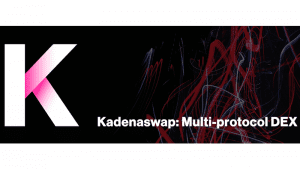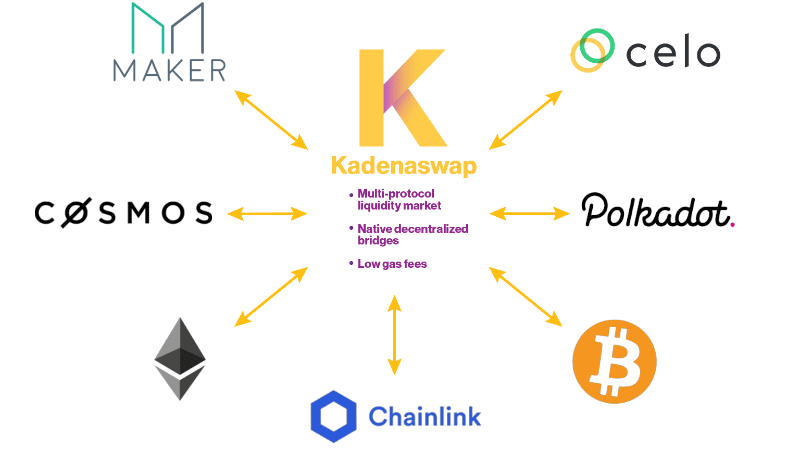
“Ethereum made DeFi possible, but congestion and high gas prices threaten the sustainability of the DeFi experiment just as it is poised to skyrocket,” said Kadena Co-founder and President Stuart Popejoy. “Kadenaswap’s support for multiple protocols and the ability to scale across the Kadena public multi-chain network will provide a much-needed, fully decentralized alternative to ‘CeFi’ on centralized exchanges and off-chain Layer-2 solutions. Combined with community efforts like our developer program launch and free gas campaign, Kadenaswap shows a way forward to mass adoption of DeFi protocols.”
DeFi and what it needs
DeFi continues to grow by billions each month. Yet the fundamental problems of Ethereum are breaking platforms and sending developers scrambling. As Ethereum is currently the infrastructure for the majority of DeFi activity, DeFi is buckling under the strain:
- gas prices are soaring to $99 per transaction
- non-DeFi applications are being crowded out
- participants are unable to operate sustainably.
Recent hacks – of Balancer, Bzx, Opyn, and dForce – with losses in the tens of millions of dollars, emphasise that developers face crippling security difficulties. This applies especially to Ethereum’s smart contract language, Solidity.
In searching for a solution to such problems, DeFi projects are seeking an alternative platforms to Ethereum. This applies as much to CeFi as DeFi. CeFi already leverages centralised exchange scalability.
Kadenaswap as an alternative
While there are layer-2 networks which push transactions off-chain (but raise centralisation concerns like those in the Lightning Network), Kadenaswap is adopting an alternative approach. Instead it leverages Kadena’s multi-chain scalability. In effect this seeks to keep the “De” in DeFi by scaling on the base layer.
It uses decentralised bridge technology in Pact (Kadena’s smart contract language) for access to major protocols. With Kadenaswap it no longer matters what chain transactions originate on. To do this Kadenaswap leverage Pact as a smart contract language to interoperate with major DeFi protocols and stablecoins (such as BTC, CELO, DAI, DOT, LINK, and ETH). It will also launch, in stages, the creation of native decentralized bridges to Ethereum (as well as other networks such as Cosmos and Polkadot).

Additionally, as the first layer-1 multi-protocol DEX, Kadenaswap will create opportunities for automated market makers (AMMs) to balance liquidity across networks. To this end, a governance token – named KDAX – is under consideration. This would enable allow stakeholders to participate in setting incentives and other mechanisms.
Kadenaswap and incentives
To increase the attractiveness of building applications on Kadena’s blockchain, the design of which ensures low gas fees and production scalability, Kadena is offering developers one month of free (gas) during October 2020. This month also sees the launch of Kadena’s developer engagement program.
In parallel ZelCore is partnering with Kadena to provide full-node incentivisation for miners. Zelcore is the preferred third party wallet recommended for the KDA token. On ZelCore’s Flux platform, full node operators can receive incentives in KDA. This is a new resource to GPU members that want to mine by running a full node. Building upon crypto gas stations, along with a month of free gas, Kadena hopes this full node operation is a compelling attraction.
Enterprise Times: what does this mean
DeFi has emerged as a potential game changer for blockchain. It is gathering increasing adoption and new participation in cryptocurrencies. With Kadenaswap aspiring to making its own particular contribution to the DeFi ecosystem. By offering free gas, a developer engagement program and full-node incentives for miners it hopes to draw participation, not least from frustrated Ethereum users.
The first stage of Kadenaswap will include bridges, ERC-20 wrapped tokens, etc. and go live in Q4 of 2020. Additional details will come, Kadena says, with the release of this roadmap – scheduled for October (2020). Kadena’s founders believe this roadmap will be credible and practical because they bring expertise derived from building J.P. Morgan’s first blockchain and work at the U.S. Securities and Exchange Commission (SEC).


























